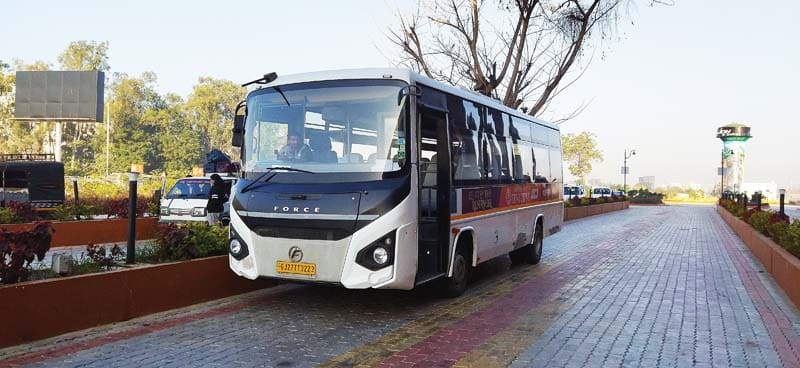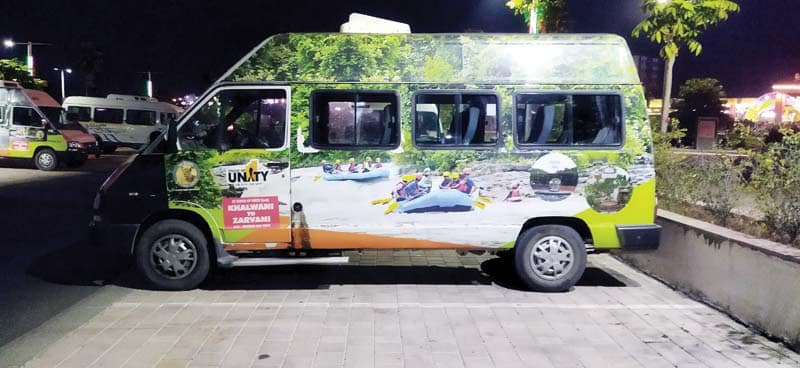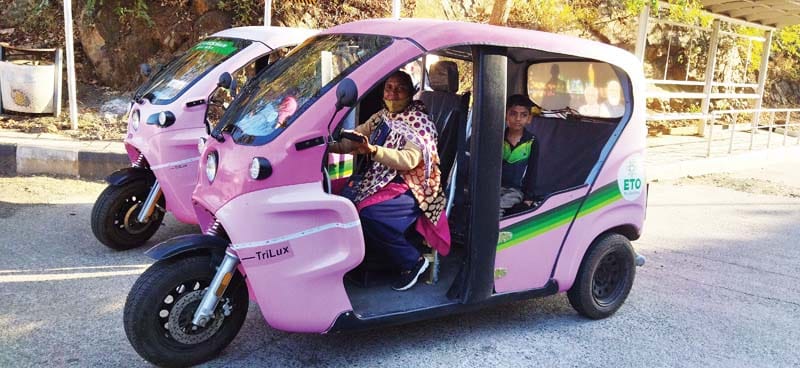Dedicated EV only, public transport mandates are limiting access to polluting vehicles in the eco-tourism pockets of the country. Ashish Bhatia visited the Statue of Unity, a special mobility zone to check on the equation.
The country has been focusing on creating eco-tourism hubs to boost the regional economy, social infrastructure, environment generation and protection and tribal development, in turn, boosting livelihood generation. In doing so, it has focused a great deal on creating special mobility zones. These special mobility zones, typically, restrict private, ICE vehicles from accessing the monuments at the centre of the zone and are a big draw for tourists. The approach to the memorial and the surrounding tourist hotspots can be accessed on foot or quicker, using cleaner mobility solutions: from electric bikes to tricycles and footboards, to electric golf carts, electric three-wheelers and e-buses at the upper end of the passenger carrying capacity in the spectrum. The business model is to offer these at fixed rates for to and fro trips, some as free shuttles, that one can opt for either as a hop-on hop-off option with other options like self-drives on a rental basis. To support these vehicles, typically, the Original Equipment Manufacturers (OEMs) enter into a partnership with the state government offering a minimum business guarantee or on a pilot, and with technology and charging infrastructure companies or they are supported under the Public Private Partnership (PPP) model like the case with electric buses, for example. This has led to the emergence of an entire ecosystem, from charging to maintenance, including driver training to help operators acclimatise in line with the zero fossil-fuel policy.
On ground zero
 To get to the Statue of Unity, a designated ‘Special Mobility Zone’, I boarded the Ekta Nagar Sf express train from the Borivali station. After an overnight journey of about eight hours, I alighted at Ekta Nagar (erstwhile Kevadia) station located in the district Rajpipla, in the state of Gujarat. A spanky new, open construction station in the Narmada district, it had street art around hinting at the newfound purpose of ‘Choosing Green’, aptly so. The exit from the station presented a host of public transport options for my onward journey. My options included a Force Motors Monobus and shared auto-rickshaws among other state-run buses that were doing the rounds as free shuttle services between the station and the grand statue. The statue, overlooking the isle of Sadhu-Bet in river Narmada and located between the Mountain Ranges of Vindhyachal and Satpuda is nearly 3.2 kms from the Sardar Sarovar Dam and its water dykes. The statue can be seen from kilometres away on the approach route in a rather exciting build-up as it reveals itself to the naked eye from different angles.
To get to the Statue of Unity, a designated ‘Special Mobility Zone’, I boarded the Ekta Nagar Sf express train from the Borivali station. After an overnight journey of about eight hours, I alighted at Ekta Nagar (erstwhile Kevadia) station located in the district Rajpipla, in the state of Gujarat. A spanky new, open construction station in the Narmada district, it had street art around hinting at the newfound purpose of ‘Choosing Green’, aptly so. The exit from the station presented a host of public transport options for my onward journey. My options included a Force Motors Monobus and shared auto-rickshaws among other state-run buses that were doing the rounds as free shuttle services between the station and the grand statue. The statue, overlooking the isle of Sadhu-Bet in river Narmada and located between the Mountain Ranges of Vindhyachal and Satpuda is nearly 3.2 kms from the Sardar Sarovar Dam and its water dykes. The statue can be seen from kilometres away on the approach route in a rather exciting build-up as it reveals itself to the naked eye from different angles.
 En route, one can’t help but notice the effort undertaken to put the landmark, a symbol of national unity, on the world map; to put in place a supporting transport infrastructure that includes and is not limited to ecycling hubs, bus depots, electric cabs, golf carts and the biggest draw for me, the electric rickshaws. An even bigger motivator to board these e-rickshaws beyond just the vehicle itself was the local women who steered them with panache at designated points that I came across on the entry route of the tourist attraction. With a newfound direction to their lives as homemakers, these women have turned adept at ferrying passengers with an unmatched zest for life and a newfound passion that is popularising mobility as a service powered by green vehicles.
En route, one can’t help but notice the effort undertaken to put the landmark, a symbol of national unity, on the world map; to put in place a supporting transport infrastructure that includes and is not limited to ecycling hubs, bus depots, electric cabs, golf carts and the biggest draw for me, the electric rickshaws. An even bigger motivator to board these e-rickshaws beyond just the vehicle itself was the local women who steered them with panache at designated points that I came across on the entry route of the tourist attraction. With a newfound direction to their lives as homemakers, these women have turned adept at ferrying passengers with an unmatched zest for life and a newfound passion that is popularising mobility as a service powered by green vehicles.
 Sangeeta ben, a middle-aged native is new to driving her e-rickshaw. Three months into the new profession she is a proud professional. With no prior experience of driving a vehicle, let alone a bicycle, she showed off her licence with a sense of immense pride. The instant torque and gearless operations have translated into a fatigue-free experience for her, she shared. She has to pay back the government a sum of Rs.900 at the end of her daily operations whether or not she is profitable in a mutual agreement. In the initial days, she had to make do with a loss of Rs.800 with her daily earnings on days with few rides amounting to a meagre Rs.100. Her operational expenses include Rs.110 for parking her e-rickshaw at designated spots like the one at the bus terminal on an adjacent strip to the main entrance of the statue. On most single routes, she can charge passengers Rs.50 which requires her to do an estimated 20 trips to break even on her daily outgoings. With her gaining experience, she was hopeful of buying the vehicle in her name from a lease arrangement opted for initially. That however is no longer an option. She informed me with disappointment. Even protests failed to convince the state government, she claimed.
Sangeeta ben, a middle-aged native is new to driving her e-rickshaw. Three months into the new profession she is a proud professional. With no prior experience of driving a vehicle, let alone a bicycle, she showed off her licence with a sense of immense pride. The instant torque and gearless operations have translated into a fatigue-free experience for her, she shared. She has to pay back the government a sum of Rs.900 at the end of her daily operations whether or not she is profitable in a mutual agreement. In the initial days, she had to make do with a loss of Rs.800 with her daily earnings on days with few rides amounting to a meagre Rs.100. Her operational expenses include Rs.110 for parking her e-rickshaw at designated spots like the one at the bus terminal on an adjacent strip to the main entrance of the statue. On most single routes, she can charge passengers Rs.50 which requires her to do an estimated 20 trips to break even on her daily outgoings. With her gaining experience, she was hopeful of buying the vehicle in her name from a lease arrangement opted for initially. That however is no longer an option. She informed me with disappointment. Even protests failed to convince the state government, she claimed.
Well-versed with her vehicle, she shared that the only downtime was the charging interval of four hours. On a single charge, she claimed, the vehicle clocked 100 kms. With the initial speed limits set at 30 kmph leading to operator fatigue, the beneficiaries like Sangeeta ben have got the authorities to consider an upward revision of the limit. Failing they fear passengers might ditch the vehicle for other faster modes of options. She shared, nearly 60 homemakers, including her, run these e-rickshaws as she manoeuvred the vehicle with confidence. Having undergone training on the KETO-manufactured TriLux badged e-rickshaw also known as the Unity e-rickshaw, ferrying passengers between popular spots on the tour itinerary, day in and day out has ensured she is well versed with the terrain. Be it the flats or the ascends and descends en route.
 Claimed to be the first, fully ground-up EV manufacturer, KETO Motors shares its DNA with the team responsible for bringing BYD electric buses to India. Painted in an attractive shade of pink, these vehicles look modern at the outset and are powered by 48V Lithium-ion battery packs. They are designed to also work with lead-acid battery packs. They are claimed to have been built on a patented unique design and can travel at speeds of up to 45 kmph with a 30-degrees gradeability on the Keto EP1. Measuring 3130 mm in length, 1315 mm in width and 1800 mm in height, the vehicle offers a good amount of space with knee room and under-thigh support for greater passenger comfort. It is also fitted with multiple safety devices including seatbelts, a sturdy rear bumper, and a bucket seat for the driver with a three-point seatbelt and a high backrest. The laminated windshield can be swept clean with its two-speed wiper system and screen wash. With seating for D+3, the interiors are roomy and comfortable for the short rides on offer. They give a sense of zipping around the well layed out roads around the Statue of Unity.
Claimed to be the first, fully ground-up EV manufacturer, KETO Motors shares its DNA with the team responsible for bringing BYD electric buses to India. Painted in an attractive shade of pink, these vehicles look modern at the outset and are powered by 48V Lithium-ion battery packs. They are designed to also work with lead-acid battery packs. They are claimed to have been built on a patented unique design and can travel at speeds of up to 45 kmph with a 30-degrees gradeability on the Keto EP1. Measuring 3130 mm in length, 1315 mm in width and 1800 mm in height, the vehicle offers a good amount of space with knee room and under-thigh support for greater passenger comfort. It is also fitted with multiple safety devices including seatbelts, a sturdy rear bumper, and a bucket seat for the driver with a three-point seatbelt and a high backrest. The laminated windshield can be swept clean with its two-speed wiper system and screen wash. With seating for D+3, the interiors are roomy and comfortable for the short rides on offer. They give a sense of zipping around the well layed out roads around the Statue of Unity.
Despite the instant torque at hand, the lightweight aluminium structure and the tyres clear the NVH test with aplomb. The only sounds are from the 5 kW capacity motor revving and the vehicle powering through the wind resistance. The lightweight high quality, ABS panels with UV protection are claimed to be easily replaceable. A fully recyclable product as per claims, the company also offers EV infrastructure and services for its first-mile, last-mile and intra-city commutes. Brake duties are done by a disc at the front and a drum at the rear. The vehicle is claimed to have been designed in compliance with the EU regulation L5Be and boasts of a modular design for local assembly. The vehicle features an LED headlamp cluster for night drives and includes reverse and interior lights.
Government impetus
A testimony to such special mobility zones being a strong focus area for the government is the approach to meet the fund requirements for the various schemes implemented by the Ministry of Tourism. During the Financial Year 2022-23 (FY2022-23), the Finance Minister, Nirmala Sitharaman earmarked an allocation of Rs.2400 crore in the Union Budget. Of this, Rs.130 crore is allocated to the development of iconic tourist destinations. Rs.12.5 crore is for the Loan Guarantee Scheme for the Covid-19 affected tourism sector. Rs.5.27 crore is set aside for the safety of women tourists to these destinations of which public transport is a vital cog. “The private sector will be encouraged to create sustainable and innovative business models for battery and energy as a service, improving the efficiency of the ecosystem,” she is quoted to have said.





















